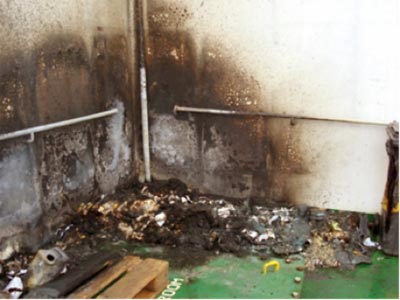Safe Storage and Disposal of Oil or Solvent-Soaked Rags
The accumulation of oil or solvent-soaked rags in the normal daily function of a shop or manufacturing environment can be a major safety issue. Oil-soaked rags are a spontaneous combustion hazard because as the oil oxidizes, heat is released. If the heat is not dissipated, it can build up and ignite the rags.

FIRE CAUSED BY SPONTANEOUS IGNITION (OILY RAGS)
Spontaneous ignition occurs when a combustible object is heated to its ignition temperature by a chemical reaction involving the oxygen in the air around us. This “oxidation” process creates heat that, if not dissipated, will build up until ignition occurs.
Controlling Spontaneous Combustion:
Store oil-soaked rags in specially designed metal cans that safely contain a self-ignited fire and control the danger of spontaneous combustion. These containers are made of metal, have self-closing covers, and should not have plastic liners These containers allow air to flow around the rags, thus dissipating the heat..
The risk of spontaneous combustion is virtually eliminated by limiting the oxygen in the container. The oxidation process will use up the oxygen in the container stopping the reaction, thus preventing a fire.
Oily waste containers should bear the label of a recognized testing laboratory such as Underwriters Laboratories. The label will ensure the product has been tested and certified to meet the high standards of safety and quality. OSHA Compliant Oily Waste Cans are essential whenever solvent soaked cloths and wiping rags are used.
OSHA Requirements:
All solvent waste, oily rags, and flammable liquids shall be kept in fire resistant covered container and removed from worksite daily.
Safety can distinguish you…Lack of safety can extinguish you!!
Download flyer: STOTW_31_DisposalOilRags.pdf (111.22 kb)

